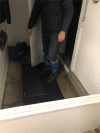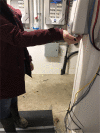Technologies monitoring and improving biosecurity compliance in barn anterooms
- PMID: 36406088
- PMCID: PMC9673170
- DOI: 10.3389/fvets.2022.1005144
Technologies monitoring and improving biosecurity compliance in barn anterooms
Abstract
People can act as mechanical vectors, and introduce and spread infectious diseases on farms. Preventive measures, such as changing boots and washing hands, need systematic implementation to manage this risk. Unfortunately, biosecurity compliance regarding biosecurity measures in barn anterooms has been shown to be generally low in all animal production systems. Indeed, the main challenge with biosecurity is maintaining compliance. The development of an effective on-farm biosecurity program requires several elements. These include farm and barn designs facilitating implementation of biosecurity measures; consistently communicating with all personnel and visitors informing them about threats and biosecurity; training programs for all farm personnel, explaining why biosecurity is effective in preventing infectious disease transmission, which measures are needed, and how to best implement them. All these components would be further optimized if automated monitoring systems were implemented with feedback mechanisms. Technologies are now available and are being adapted to the farm context to monitor biosecurity compliance. Two pilot projects using radio-frequency-identification-based (RFID) real-time continuous automated monitoring system quantifying hand sanitizing and boot compliance were conducted. The first one (MediHand Trace system) was a system designed to monitor and provide real-time feedback for handwashing in a hospital environment. It was functional for this task, although not sturdy enough for long-term use in a farm environment. The second system was a prototype designed for barns and with foot mats allowing the monitoring of footwear management as well as handwashing. These pilot studies have shown that real-time feedback helps improve compliance. However, the efficacy of the systems was very dependent on the physical set-up of the anteroom.
Keywords: RFID; anteroom; biosecurity; compliance; monitoring; technology; traffic.
Copyright © 2022 Racicot, Cardinal, Tremblay and Vaillancourt.
Conflict of interest statement
The authors declare that the research was conducted in the absence of any commercial or financial relationships that could be construed as a potential conflict of interest.
Figures








Similar articles
-
Making the invisible visible: Effectiveness of a training program to increase awareness and biosecurity compliance in poultry barn anterooms, using glowing substances.Prev Vet Med. 2024 Dec;233:106349. doi: 10.1016/j.prevetmed.2024.106349. Epub 2024 Sep 21. Prev Vet Med. 2024. PMID: 39317119
-
Evaluation of strategies to enhance biosecurity compliance on poultry farms in Québec: effect of audits and cameras.Prev Vet Med. 2012 Feb 1;103(2-3):208-18. doi: 10.1016/j.prevetmed.2011.08.004. Epub 2011 Sep 13. Prev Vet Med. 2012. PMID: 21917344
-
Preventive effect of on-farm biosecurity practices against highly pathogenic avian influenza (HPAI) H5N6 infection on commercial layer farms in the Republic of Korea during the 2016-17 epidemic: A case-control study.Prev Vet Med. 2022 Feb;199:105556. doi: 10.1016/j.prevetmed.2021.105556. Epub 2021 Dec 3. Prev Vet Med. 2022. PMID: 34896940
-
Biosecurity in pig farms: a review.Porcine Health Manag. 2021 Jan 4;7(1):5. doi: 10.1186/s40813-020-00181-z. Porcine Health Manag. 2021. PMID: 33397483 Free PMC article. Review.
-
Review of transmission routes of 24 infectious diseases preventable by biosecurity measures and comparison of the implementation of these measures in pig herds in six European countries.Transbound Emerg Dis. 2018 Apr;65(2):381-398. doi: 10.1111/tbed.12758. Epub 2017 Nov 9. Transbound Emerg Dis. 2018. PMID: 29124908 Review.
Cited by
-
How Do Flemish Laying Hen Farmers and Private Bird Keepers Comply with and Think about Measures to Control Avian Influenza?Vet Sci. 2024 Oct 5;11(10):475. doi: 10.3390/vetsci11100475. Vet Sci. 2024. PMID: 39453067 Free PMC article.
-
Supporting Measures to Improve Biosecurity within Italian Poultry Production.Animals (Basel). 2024 Jun 8;14(12):1734. doi: 10.3390/ani14121734. Animals (Basel). 2024. PMID: 38929353 Free PMC article.
-
Quantitative Risk Assessment of Wind-Supported Transmission of Highly Pathogenic Avian Influenza Virus to Dutch Poultry Farms via Fecal Particles from Infected Wild Birds in the Environment.Pathogens. 2024 Jul 8;13(7):571. doi: 10.3390/pathogens13070571. Pathogens. 2024. PMID: 39057798 Free PMC article.
-
Stakeholders' Perceptions of Biosecurity Implementation in Italian Poultry Farms.Animals (Basel). 2023 Oct 18;13(20):3246. doi: 10.3390/ani13203246. Animals (Basel). 2023. PMID: 37893970 Free PMC article.
-
Connecting livestock disease dynamics to human learning and biosecurity decisions.Front Vet Sci. 2023 Jan 20;9:1067364. doi: 10.3389/fvets.2022.1067364. eCollection 2022. Front Vet Sci. 2023. PMID: 36744225 Free PMC article.
References
-
- Toma B, Vaillancourt J-P, Dufour B, Eloit M, Moutou F, Marsh W, et al. . Dictionary of Veterinary Epidemiology. Ames, IA: Wiley-Blackwell. p. 284 (1999).
-
- Shane SM. Preventing erosive diseases in broiler parents. Zootecnica Int. (1993) 16:58–60.
LinkOut - more resources
Full Text Sources

